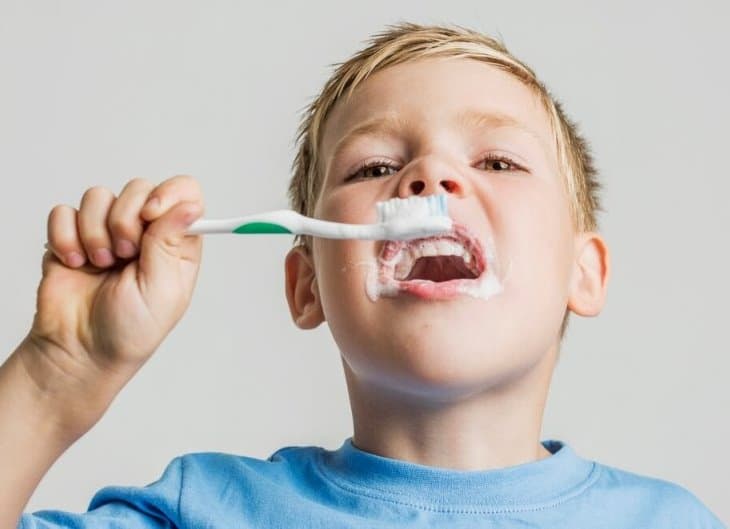Swallowing a small amount of fluoride toothpaste is usually harmless. Consuming large amounts can cause stomach pain and vomiting.
Fluoride toothpaste is essential for maintaining dental health. It helps to prevent cavities and strengthens tooth enamel. While brushing, some people may accidentally swallow a bit of toothpaste. For most, this isn’t a cause for concern. The fluoride in the toothpaste is designed to protect teeth, not harm your stomach.
But ingesting large quantities can lead to adverse effects like stomach pain, nausea, or even more severe symptoms in extreme cases. It’s crucial to supervise children while brushing to ensure they use a pea-sized amount and avoid swallowing. Always seek medical advice if large amounts are ingested to ensure safety.
Common Ingredients of Fluoride Toothpaste
Fluoride toothpaste has many ingredients. Some of the common ones include fluoride, abrasives, and flavoring agents. Fluoride helps protect teeth from cavities.
It fights against tooth decay. It also helps repair the early stages of tooth damage. This is very important for keeping your teeth healthy. Fluoride is found in most toothpastes. It can also be found in drinking water.
Abrasives help remove food particles and stains. Flavoring agents make the toothpaste taste good. Other ingredients may include humectants to keep it moist and binding agents to hold it together.
Read More: Ways to prevent 5 common dental conditions
Accidental Swallowing
Kids may swallow fluoride toothpaste by accident. They might like the taste. Sometimes, they may not know it’s bad to swallow. Adults can also swallow while brushing too fast. Always be careful and watch kids while they brush.
Stay calm if someone swallows toothpaste. Give them a glass of water or milk. This can help dilute the fluoride. Do not panic but keep an eye on them. If they feel sick, call a doctor or poison control.
Short-term Effects
Swallowing fluoride toothpaste can cause stomach pain. You might feel nauseous or need to vomit. Some people get diarrhea. These symptoms are usually mild and go away on their own. It’s important to drink plenty of water. This helps to flush the fluoride out of your system.
Ingesting a lot of fluoride can lead to fluoride poisoning. Symptoms include headaches and dizziness. You may also experience muscle weakness.
Severe cases can cause convulsions. If you have these symptoms, you should seek medical help right away. It’s rare, but it can be very serious.
Long-term Risks
Dental fluorosis affects teeth appearance. White spots or streaks may appear on teeth. This happens due to too much fluoride. Kids are more at risk. It’s important to use the right amount of toothpaste. Pea-sized is enough for kids.
Skeletal fluorosis affects bones. High fluoride intake can make bones weak. Pain and stiffness are common symptoms. This condition is rare. It happens over many years. Safe fluoride levels are important for health.
Recommended Dosage
Fluoride toothpaste is safe when used correctly. Children under 3 years should use a rice-grain-sized amount. Children aged 3 to 6 should use a pea-sized amount. Adults can use about 1 to 2 centimeters of toothpaste. This ensures they get the right amount of fluoride.
Preventive Measures
Children should always be supervised while brushing their teeth. Use only a small, pea-sized amount of toothpaste. Teach children to spit out toothpaste after brushing. Swallowing too much fluoride toothpaste can be harmful. Always store toothpaste out of reach of young children.
Use the right amount of toothpaste for each brushing session. Adults should also follow this rule. Fluoride is good in small amounts but harmful in large amounts. Rinse your mouth thoroughly after brushing. This helps to remove any excess toothpaste.
Alternatives To Fluoride Toothpaste
Natural toothpaste options are gaining popularity. They use natural ingredients like baking soda, coconut oil, and essential oils. These ingredients help clean teeth without the need for fluoride. Some natural toothpastes also contain charcoal for whitening. Kids can use these products safely. They do not contain harsh chemicals.
Many companies offer fluoride-free toothpaste for those who want to avoid fluoride. These products still protect teeth from cavities. They use alternative ingredients to strengthen enamel. Some options include xylitol, which is a natural sweetener. Xylitol helps reduce bacteria in the mouth. Fluoride-free products are also available for sensitive teeth.
When To Seek Medical Help
Swallowing a small amount of toothpaste is usually safe. Large amounts can cause problems. Watch for signs like vomiting, diarrhea, and stomach pain. Feeling dizzy or having trouble breathing are serious. These signs mean you need medical help fast.
If someone swallows a lot of toothpaste, call Poison Control right away. Do not make the person vomit unless a doctor says so. Give them a glass of milk or water to drink. This helps dilute the fluoride in their stomach. Stay calm and follow instructions from medical experts.
Conclusion
Swallowing fluoride toothpaste can lead to mild to serious symptoms. Always supervise children during brushing. Seek medical attention if needed.
Using the correct amount of toothpaste is crucial for safety. Proper dental care habits help prevent accidental ingestion. Stay informed to protect your health and maintain a safe oral hygiene routine.
